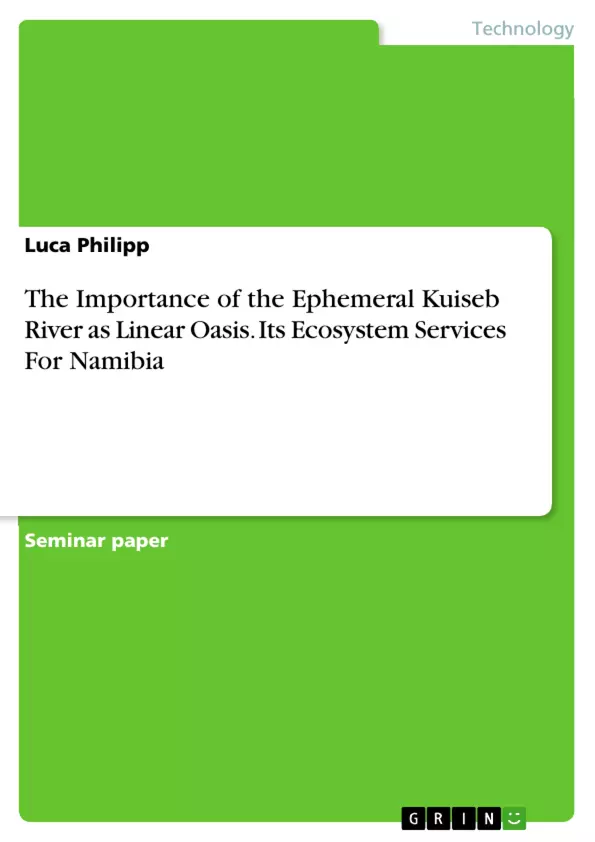Ephemeral rivers, such as the Kuiseb, are from tremendous importance for the dependent ecosystems, economies and people that rely on its water resources. It is part of a unique landscape, which has formed under extreme conditions. Highly specialized, often endemic species were able to emerge. This study sets forth to consider in detail some of its unique features.
The Topnaar (≠Aonin) are an indigenous population living along the Kuiseb for centuries that has managed to practice agriculture in this very barren and hyper-arid landscape mainly by cultivating native, endemic plants. To emphasize this, the Ecosystem services model (MA [Millenium Ecosystem Assessment], 2005) was applied to identify and classify the ecosystem services offerd by the Kuiseb River. The study will also take a look at Namibias community-based natural resource management (CBNRM) which is one of the longest established payment for ecosystem services scheme of the world. Moreover, the Kuiseb Basin Management Committee (KBMC) will be considered, which strives to provide efficient and equitable access to water and sustainable use of related resources in the Kuiseb River basin.
Inhaltsverzeichnis (Table of Contents)
- Introduction
- 1. Introduction
- Study area
- 2. Study area
- 2.1 Location and Landscape
- 2.2 Geology
- 2.3 Climate
- 2.4 Hydrology
Zielsetzung und Themenschwerpunkte (Objectives and Key Themes)
This research aims to emphasize the importance of the ephemeral Kuiseb River in Namibia, focusing on its natural resources and ecosystem services for the dependent ecosystems, humans, and economies. It applies the ecosystem services model to analyze the Kuiseb River, considering the significance of community-based natural resource management and the role of a basin management committee.
- The vital role of ephemeral rivers, like the Kuiseb, in arid environments.
- The ecosystem services provided by the Kuiseb River.
- The impact of community-based natural resource management on the Kuiseb River basin.
- The significance of basin management committees in ensuring sustainable water access and resource use.
- The unique adaptation strategies of the Topnaar (#Aonin) indigenous population living along the Kuiseb River.
Zusammenfassung der Kapitel (Chapter Summaries)
- Introduction:
- This chapter introduces the concept of ephemeral rivers and their importance, especially in the context of Namibia, a dry-climate country with a water deficit.
- It highlights the need for sustainable management strategies to address growing demands for resources and the challenges posed by climate change.
- The research focuses on the Kuiseb River as a critical water resource for dependent ecosystems, human communities, and economies.
- Study area:
- This chapter provides a detailed description of the Kuiseb River basin, its location, and the surrounding landscape.
- It covers the geological formations, including the Damara Supergroup and Gariop Complex, and the presence of younger rocks from the Karoo sequence.
- The chapter also discusses the climate, characterized by semi-arid to arid conditions, with varying rainfall patterns and temperatures.
- It examines the unique hydrology of the Kuiseb River, emphasizing its ephemeral nature and the role of precipitation events in driving its flow.
Schlüsselwörter (Keywords)
This research focuses on the following keywords and topics: ephemeral river, ecosystem services, community-based natural resource management, basin management committee, Namibia, arid environments, conservation, water resources, riparian forest, vegetation, indigenous populations, Topnaar (#Aonin), Kuiseb River.
- Arbeit zitieren
- Luca Philipp (Autor:in), 2020, The Importance of the Ephemeral Kuiseb River as Linear Oasis. Its Ecosystem Services For Namibia, München, GRIN Verlag, https://www.hausarbeiten.de/document/1040525


